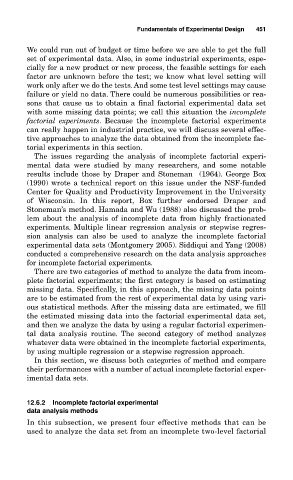Page 492 - Design for Six Sigma a Roadmap for Product Development
P. 492
Fundamentals of Experimental Design 451
We could run out of budget or time before we are able to get the full
set of experimental data. Also, in some industrial experiments, espe-
cially for a new product or new process, the feasible settings for each
factor are unknown before the test; we know what level setting will
work only after we do the tests. And some test level settings may cause
failure or yield no data. There could be numerous possibilities or rea-
sons that cause us to obtain a final factorial experimental data set
with some missing data points; we call this situation the incomplete
factorial experiments. Because the incomplete factorial experiments
can really happen in industrial practice, we will discuss several effec-
tive approaches to analyze the data obtained from the incomplete fac-
torial experiments in this section.
The issues regarding the analysis of incomplete factorial experi-
mental data were studied by many researchers, and some notable
results include those by Draper and Stoneman (1964). George Box
(1990) wrote a technical report on this issue under the NSF-funded
Center for Quality and Productivity Improvement in the University
of Wisconsin. In this report, Box further endorsed Draper and
Stoneman’s method. Hamada and Wu (1988) also discussed the prob-
lem about the analysis of incomplete data from highly fractionated
experiments. Multiple linear regression analysis or stepwise regres-
sion analysis can also be used to analyze the incomplete factorial
experimental data sets (Montgomery 2005). Siddiqui and Yang (2008)
conducted a comprehensive research on the data analysis approaches
for incomplete factorial experiments.
There are two categories of method to analyze the data from incom-
plete factorial experiments; the first category is based on estimating
missing data. Specifically, in this approach, the missing data points
are to be estimated from the rest of experimental data by using vari-
ous statistical methods. After the missing data are estimated, we fill
the estimated missing data into the factorial experimental data set,
and then we analyze the data by using a regular factorial experimen-
tal data analysis routine. The second category of method analyzes
whatever data were obtained in the incomplete factorial experiments,
by using multiple regression or a stepwise regression approach.
In this section, we discuss both categories of method and compare
their performances with a number of actual incomplete factorial exper-
imental data sets.
12.6.2 Incomplete factorial experimental
data analysis methods
In this subsection, we present four effective methods that can be
used to analyze the data set from an incomplete two-level factorial

